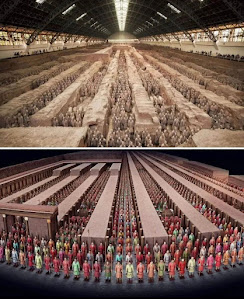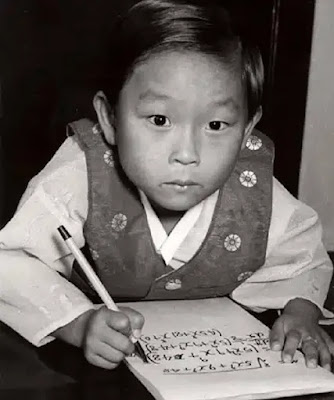Terracotta Army.
It is believed that the Terracotta Army, referring to the soldiers guarding the tomb of Qin Shi Huang, looked like this when they were first crafted around 2200 years ago.
Each life-size clay warrior was crafted to be completely unique and there are no two terracotta warriors-among the 8,000 total—that are exactly the same.
Shortly after the completion of the tomb in 210-209 BC, it was looted for weapons and burned, causing the roof to collapse, crushing the terracotta warriors. All the other terracotta warriors that are currently on display were painstakingly restored. What's even more remarkable is that the terracotta warriors were originally painted in bright colors by skilled artisans.
Unfortunately, when they were exposed to air and sunlight during the excavation in the 1970s, the colors began to curl up almost immediately and disappeared within minutes.
These terracotta warriors were put in place to guard the tomb of the first emperor of unified China—-Qin Shi Huang. To this day, the tomb has yet to be opened. According to ancient historians, the tomb contains an entire kingdom and palace in which the ceilings are decorated with pearls to mimic the night sky. The tomb is also said to contain extremely rare artifacts and has been rigged with crossbows to shoot anyone trying to break in. To keep its location a secret, the workers were entombed with the emperor.
The Han dynasty historian, Sima Qian, also mentioned that inside the tomb, "mercury was used to fashion the hundred rivers, the Yellow River and the Yangtze River, and the seas in such a way that they flowed." Modern tests have indicated extremely high levels of mercury in the surrounding soil..
This is one of the only terracotta warriors that was found almost completely intact. Note the detail on the bottom of his shoe, showing that grip and traction were considered in footwear even 2,200 years ago.
The individuality and attention to detail in each terracotta warrior are truly remarkable aspects of this ancient masterpiece. Here are more fascinating details about the terracotta army and the tomb of Qin Shi Huang:
**Unique Characteristics:**
- **Footwear Detail:** The meticulous attention to detail, including the grip on the bottom of the warrior's shoe, reflects the craftsmanship and consideration for practical aspects like traction.
- **Individuality:** Craftsmen ensured that each of the approximately 8,000 terracotta warriors was unique, with distinct facial features, hairstyles, and armor.
**Tragic History:**
- **Looting and Destruction:** Shortly after the completion of the tomb around 210-209 BC, it fell victim to looting and burning. The looters targeted the warriors for their valuable weapons, causing the roof to collapse and crushing the terracotta army.
- **Restoration Efforts:** The warriors on display today underwent extensive restoration efforts, with skilled artisans meticulously piecing together the shattered fragments. This process has allowed us to marvel at the army's original grandeur.
**Vivid Colors and Preservation Challenges:**
- **Original Paint:** Originally, the terracotta warriors were adorned with bright colors, showcasing the artistic sophistication of the Qin Dynasty.
- **Color Preservation:** Tragically, exposure to air and sunlight during the 1970s excavation led to the rapid deterioration of the vibrant colors, underscoring the challenges of preserving ancient pigments.
**Tomb of Qin Shi Huang:**
- **Secrecy and Intricate Design:** Ancient accounts describe the tomb as an elaborate structure containing a kingdom and palace. Ceilings were said to be adorned with pearls to simulate the night sky.
- **Protective Measures:** To safeguard the tomb, legends suggest the presence of crossbows ready to thwart intruders. The burial site is said to be rigged with mechanisms to shoot anyone attempting to breach its secrets.
**Mercury Rivers:**
- **Historical Accounts:** According to Han dynasty historian Sima Qian, mercury was used to replicate rivers and seas inside the tomb.
- **Modern Discoveries:** Soil tests around the tomb have indeed revealed elevated levels of mercury, supporting the ancient accounts of its use in the tomb's intricate features.
The tomb of Qin Shi Huang remains sealed, harboring mysteries and treasures that continue to captivate the imagination. It stands as a testament to the innovative engineering, artistic prowess, and complex beliefs of ancient China.1974 photograph showing the true colors of the freshly unearthed Terracotta Warriors in the tomb of Emperor Qin Shi Huang, before rapid deterioration due to environmental exposures






Comments
Post a Comment